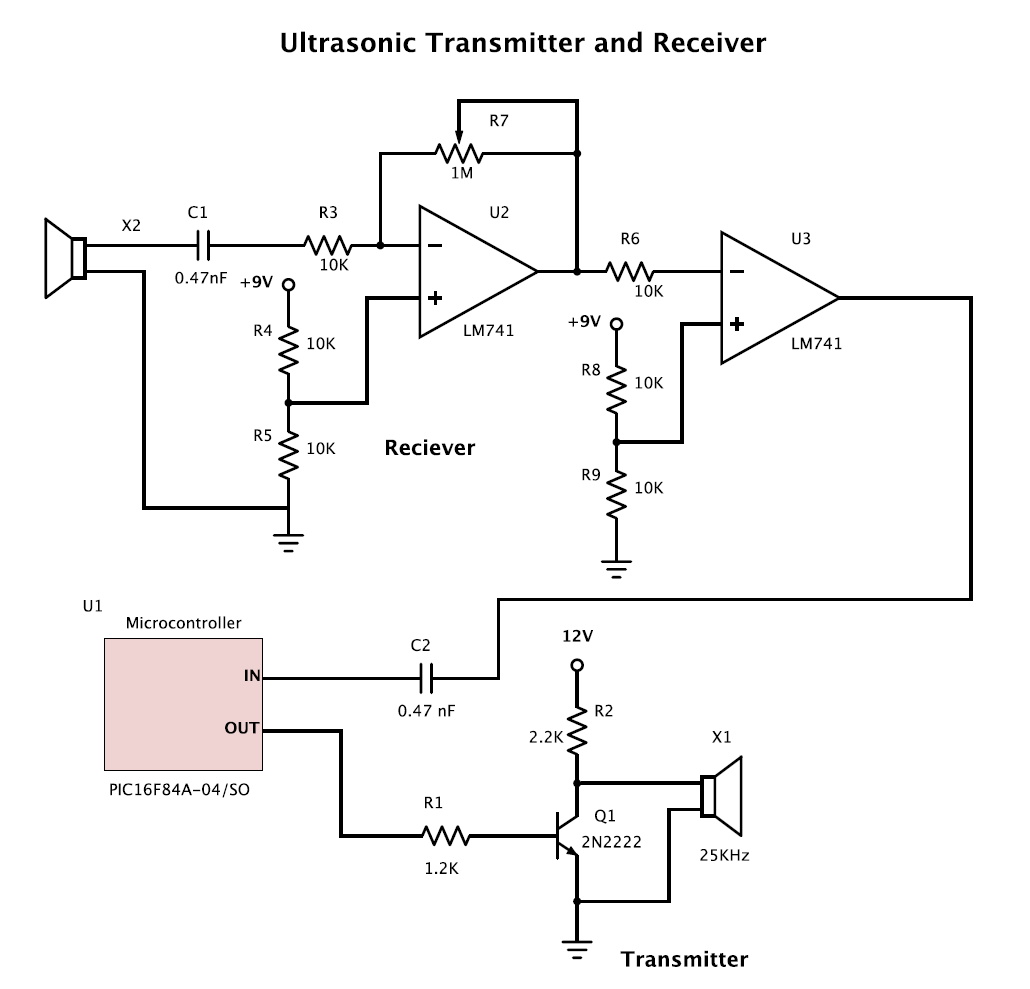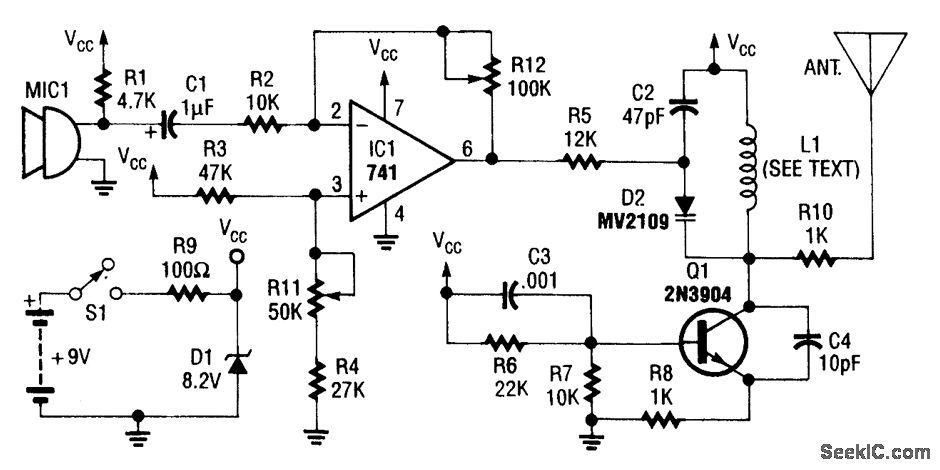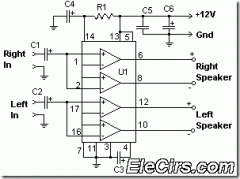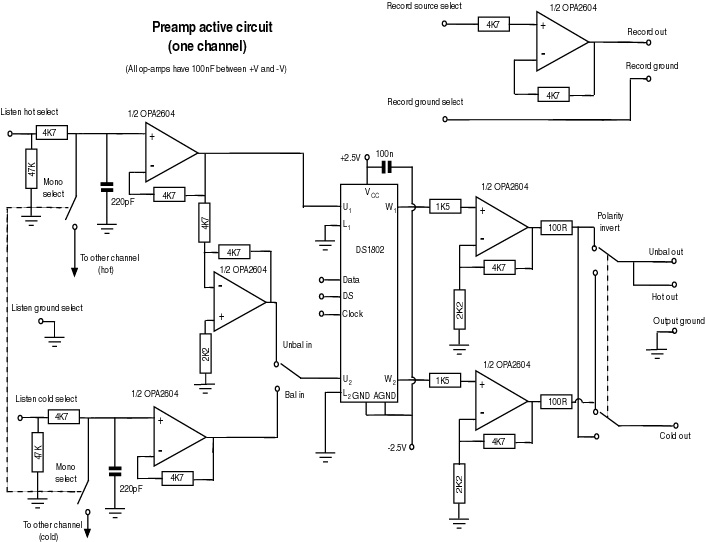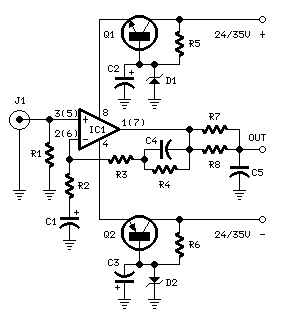
Sound Blaster Microphone Preamplifier

The circuit is fundamentally based on a well-tested simple microphone preamplifier design. A prototype of this circuit has been constructed and has demonstrated effective performance. The Sound Blaster soundcard series (SB16, SB32, AWE32, and AWE64) features a microphone input intended for use with electret microphones that are often included in soundcard packages or sold separately. The input specifications are as follows: it has an unbalanced low impedance input with a sensitivity of approximately -20dBV (100mV or 0.1 Volt) and an input impedance ranging from 600 to 1500 Ohms. The input connector is a 3.5mm miniplug (stereo jack), where audio is connected to the tip, ground to the sleeve, and a 5V DC bias is applied to the ring. Due to the high input level requirements of the microphone input, it is not suitable for use with any microphone type other than electret capsule microphones. Connecting a dynamic microphone, which typically outputs a few millivolts, results in a very low signal level accompanied by significant noise. Dynamic microphones can be connected to Sound Blaster soundcards if a suitable microphone preamplifier is constructed to amplify the dynamic microphone signal levels sufficiently for Sound Blaster compatibility. This amplification can be achieved using a simple single transistor microphone preamplifier circuit, which provides an amplification factor of about 30-50, adequate to elevate the signals from dynamic microphones to levels suitable for Sound Blaster. The simplicity of the circuit means that amplification may not be precisely defined, as it relies on the varying parameters of the transistor used, and the overall performance may not be optimal. A notable advantage of this circuit is that it does not require an external power supply, as it utilizes the +5V bias voltage typically supplied by Sound Blaster for electret microphones. This circuit has been successfully tested with the AKG D 60 S dynamic microphone and the Sound Blaster 16. By implementing this circuit, higher-quality microphones can be connected to soundcards, improving audio input compared to standard multimedia microphones. However, it should be noted that using a better microphone does not guarantee improved sound quality due to the poor frequency response of the preamplifier in SB16 cards. For enhanced audio quality, it may be advisable to construct a more sophisticated microphone preamplifier design and connect it to the line-level input of the Sound Blaster.
The circuit design includes the following components:
- R1: 1 kΩ resistor
- R2: 220 kΩ resistor
- R3: 4.7 kΩ resistor
- C1: 15 µF, 10V electrolytic capacitor (substitutes of 10 µF or 22 µF can be used if 15 µF is unavailable)
- C2: 22 µF, 10V electrolytic capacitor
- C3: 47 µF, 10V electrolytic capacitor
- Q1: BC547B transistor
The arrangement of these components is crucial for achieving the desired amplification and ensuring compatibility with the Sound Blaster microphone input. The resistors set the biasing and gain levels, while the capacitors handle coupling and decoupling, stabilizing the circuit performance. The BC547B transistor serves as the primary amplification element, and its characteristics will influence the overall gain and noise performance of the circuit. Proper layout and soldering techniques should be employed to minimize noise and interference, ensuring optimal operation of the microphone preamplifier circuit.Circuit is based basically on quite well tested my simple microphone preamplifier. I have built one prototype of this circuit and it worked nicely. Soundblaster soundcard series (SB16, SB32, AWE32 and AWE64) have all a microphone input designed to be used with the electret microphones which come with the soundcard package (some pac kages) or with separate microphone designed to be used with SoundBlaster soundcards (there are separate microphones and some monitors have built-in microphones like this). Input Type: Unbalanced Low Impedance Input Sensitivity: Approx. -20dBV (100mV or 0. 1Volt) Input Impedance: 600 to 1500. (Ohms) Input Connector: 3. 5mm Miniplug (Stereo Jack) Input Wiring: Audio on Tip, Ground on Sleeve, 5Volts DC Bias on Ring Because the microphone input needs very high input levels it is not suitable to be used with any other micophone type than elecret capsule microphones.
If you connect a dynamic microphone (which gives typically few mV voltage) and try to record it you will get very low signal level with lots of noise. Dynamic microphones can be connected to SoundBlaster if a suitable microphone preamplifier is built which can amplify the signal levels from dynamic microphones so much that they give enough level for SoundBlaster.
This amplification can be quite easily done using simple single transistor microphone preamplifier circuit: This circuit gives amplification of about 30-50 which is enough to make the signals from dynamic microphones enough high to be handled well by SoundBlaster. The circuit is very simple so the amplification is not accurately defined (depends on transistor parameters which can vary from transistor to transistor) and other performance figures are not the best possible.
The circuit has a very nice feature that it does not need any external power supply because it uses the bias voltage (+5V) which SoundBlaster sends normally to the electric microphone as it`s power source. I have used this circuit succesfully with AKG D 60 S dynamic microphone and Sound Blaster 16. Using this circuit you can add better microphones than those cheap multimedia microphones to your soundcards quite easily.
With all SoundBlasters a better microphone is not yeat a guarantee for better sound quality because the poor frequency response of the microphone preamplifier in SB16 cards. If your want even better sound quality you might consider building by simple microphone preamplifier design and connect it to the line level input of your SoundBlaster.
R1 1 kohm R2 220 kohm R3 4. 7 kohm C1 15 uF 10V electrolytic (you use 10 uF or 22 uF if you can`t find 15 uF easily) C2 22 uF 10V electrolytic C3 47 uF 10V electrolytic Q1 BC547B 🔗 External reference
The circuit design includes the following components:
- R1: 1 kΩ resistor
- R2: 220 kΩ resistor
- R3: 4.7 kΩ resistor
- C1: 15 µF, 10V electrolytic capacitor (substitutes of 10 µF or 22 µF can be used if 15 µF is unavailable)
- C2: 22 µF, 10V electrolytic capacitor
- C3: 47 µF, 10V electrolytic capacitor
- Q1: BC547B transistor
The arrangement of these components is crucial for achieving the desired amplification and ensuring compatibility with the Sound Blaster microphone input. The resistors set the biasing and gain levels, while the capacitors handle coupling and decoupling, stabilizing the circuit performance. The BC547B transistor serves as the primary amplification element, and its characteristics will influence the overall gain and noise performance of the circuit. Proper layout and soldering techniques should be employed to minimize noise and interference, ensuring optimal operation of the microphone preamplifier circuit.Circuit is based basically on quite well tested my simple microphone preamplifier. I have built one prototype of this circuit and it worked nicely. Soundblaster soundcard series (SB16, SB32, AWE32 and AWE64) have all a microphone input designed to be used with the electret microphones which come with the soundcard package (some pac kages) or with separate microphone designed to be used with SoundBlaster soundcards (there are separate microphones and some monitors have built-in microphones like this). Input Type: Unbalanced Low Impedance Input Sensitivity: Approx. -20dBV (100mV or 0. 1Volt) Input Impedance: 600 to 1500. (Ohms) Input Connector: 3. 5mm Miniplug (Stereo Jack) Input Wiring: Audio on Tip, Ground on Sleeve, 5Volts DC Bias on Ring Because the microphone input needs very high input levels it is not suitable to be used with any other micophone type than elecret capsule microphones.
If you connect a dynamic microphone (which gives typically few mV voltage) and try to record it you will get very low signal level with lots of noise. Dynamic microphones can be connected to SoundBlaster if a suitable microphone preamplifier is built which can amplify the signal levels from dynamic microphones so much that they give enough level for SoundBlaster.
This amplification can be quite easily done using simple single transistor microphone preamplifier circuit: This circuit gives amplification of about 30-50 which is enough to make the signals from dynamic microphones enough high to be handled well by SoundBlaster. The circuit is very simple so the amplification is not accurately defined (depends on transistor parameters which can vary from transistor to transistor) and other performance figures are not the best possible.
The circuit has a very nice feature that it does not need any external power supply because it uses the bias voltage (+5V) which SoundBlaster sends normally to the electric microphone as it`s power source. I have used this circuit succesfully with AKG D 60 S dynamic microphone and Sound Blaster 16. Using this circuit you can add better microphones than those cheap multimedia microphones to your soundcards quite easily.
With all SoundBlasters a better microphone is not yeat a guarantee for better sound quality because the poor frequency response of the microphone preamplifier in SB16 cards. If your want even better sound quality you might consider building by simple microphone preamplifier design and connect it to the line level input of your SoundBlaster.
R1 1 kohm R2 220 kohm R3 4. 7 kohm C1 15 uF 10V electrolytic (you use 10 uF or 22 uF if you can`t find 15 uF easily) C2 22 uF 10V electrolytic C3 47 uF 10V electrolytic Q1 BC547B 🔗 External reference
